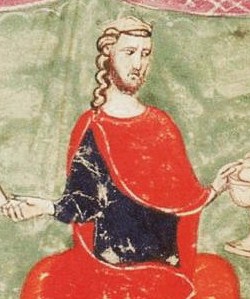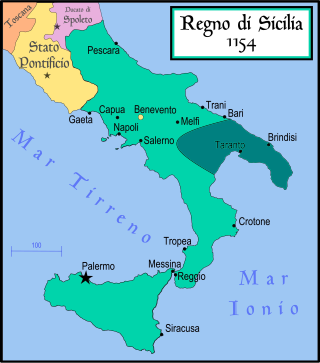
Year 1154 (MCLIV) was a common year starting on Friday of the Julian calendar.
The 1100s was a decade of the Julian Calendar which began on January 1, 1100, and ended on December 31, 1109.

Peter III of Aragon was King of Aragon, King of Valencia, and Count of Barcelona from 1276 to his death. At the invitation of some rebels, he conquered the Kingdom of Sicily and became King of Sicily in 1282, pressing the claim of his wife, Constance II of Sicily, uniting the kingdom to the crown.

Philip III, called the Bold, was King of France from 1270 until his death in 1285. His father, Louis IX, died in Tunis during the Eighth Crusade. Philip, who was accompanying him, returned to France and was anointed king at Reims in 1271.
Bohemond I of Antioch, also known as Bohemond of Taranto or Bohemond of Hauteville, was the prince of Taranto from 1089 to 1111 and the prince of Antioch from 1098 to 1111. He was a leader of the First Crusade, leading a contingent of Normans on the quest eastward. Knowledgeable about the Byzantine Empire through earlier campaigns with his father, he was the most experienced military leader of the crusade.

Bohemond II was Prince of Taranto from 1111 to 1128 and Prince of Antioch from 1111/1119 to 1130. He was the son of Bohemond I, who in 1108 was forced to submit to the authority of the Byzantine Empire in the Treaty of Devol. Three years later, the infant Bohemond inherited the Principality of Taranto under the guardianship of his mother, Constance of France. The Principality of Antioch was administered by his father's nephew, Tancred, until 1111. Tancred's cousin, Roger of Salerno, managed the principality from 1111 to 1119. After Roger died in the Battle of the Field of Blood, Baldwin II of Jerusalem took over the administration of Antioch. However, he did acknowledge Bohemond's right to personally rule the principality upon reaching the age of majority.

Robert "Guiscard" de Hauteville, sometimes Robert "the Guiscard", was a Norman adventurer remembered for his conquest of southern Italy and Sicily in the 11th century.
William I, called the Bad or the Wicked, was the second king of Sicily, ruling from his father's death in 1154 to his own in 1166. He was the fourth son of Roger II and Elvira of Castile.

Margaret of Navarre was Queen of Sicily as the wife of William I (1154–1166) and the regent during the minority of her son, William II.

Roger Borsa was the Norman Duke of Apulia and Calabria and effective ruler of southern Italy from 1085 until his death.

The Principality of Taranto was a state in southern Italy created in 1088 for Bohemond I, eldest son of Robert Guiscard, as part of the peace between him and his younger brother Roger Borsa after a dispute over the succession to the Duchy of Apulia.

Alfonso, also called Anfuso or Anfusus (c. 1120 – 10 October 1144), was the Prince of Capua from 1135 and Duke of Naples from 1139. He was an Italian-born Norman of the noble Hauteville family. After 1130, when his father Roger became King of Sicily, he was the third in line to the throne; second in line after the death of an older brother in 1138. He was the first Hauteville prince of Capua after his father conquered the principality from the rival Norman Drengot family. He was also the first Norman duke of Naples after the duchy fell vacant on the death of the last Greek duke. He also expanded his family's power northwards, claiming lands also claimed by the Papacy, although he was technically a vassal of the Pope for his principality of Capua.
Gilbert was a Norman Count of Gravina from 1159 until 1167. His father Bertrand was the illegitimate son of Rotrou III, Count of Perche. He was a cousin of Margaret of Navarre, the queen of Sicily. He arrived in Sicily sometime around 1159 and, through Margaret's influence, was created Count of Gravina in Apulia immediately.
Richard of Mandra was a Norman nobleman in the Kingdom of Sicily appointed count of Molise and chancellor by the queen regent Margaret of Navarre.

The Hauteville was a Norman family originally of seigneurial rank from the Cotentin. The Hautevilles rose to prominence through their part in the Norman conquest of southern Italy. By 1130, one of their members, Roger II, was made the first King of Sicily. His male-line descendants ruled Sicily until 1194. Some Italian Hautevilles took part in the First Crusade and the founding of the Principality of Antioch (1098).
Richard the Qaid was a senior official of the royal council in the court of the Norman Kingdom of Sicily at Palermo during the latter years of the reign of William I of Sicily and during the regency of his wife, Margaret of Navarre, for their son William II. He was already the Great Chamberlain, or magister camerarius, when William I died in 1166.
Bohemond of Tarsia was the Norman count of Tarsia and Manoppello in the Abruzzi. Invested by Roger II of Sicily on an unknown date, Bohemond's politics centred on controlling the monastery of Casauria.

The Norman conquest of southern Italy lasted from 999 to 1139, involving many battles and independent conquerors.

The County of Apulia and Calabria, later the Duchy of Apulia and Calabria, was a Norman state founded by William of Hauteville in 1042 in the territories of Gargano, Capitanata, Apulia, Vulture, and most of Campania. It became a duchy when Robert Guiscard was raised to the rank of duke by Pope Nicholas II in 1059.
Robert of Lauro was the Count of Caserta, a powerful nobleman and administrator in the Kingdom of Sicily, "effectively the king's viceroy on the mainland" between 1171 and his death. He was a close colleague of Count Tancred of Lecce, the future king. His influence helped his cousin Roger become Archbishop of Benevento (1179–1225).